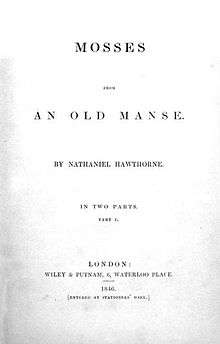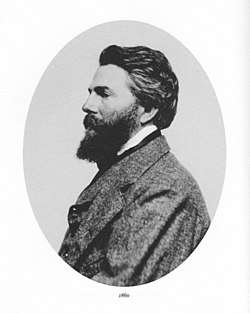Hawthorne and His Mosses
"Hawthorne and His Mosses" (1850) is an essay and critical review by Herman Melville of the short story collection Mosses from an Old Manse written by Nathaniel Hawthorne in 1846. Published pseudonymously by "a Virginian spending July in Vermont", it appeared in The Literary World magazine in two issues: August 17 and August 24, 1850. An early, literary expression of the mid-nineteenth century Young America movement, the work has been cited as an important commentary on, and analysis of, the emerging "New American Literature."

Background

Melville met the author Nathaniel Hawthorne at a picnic and an ensuing hike up Monument Mountain in the Berkshires of western Massachusetts on August 5, 1850. Also among the hikers were James Thomas Fields, Cornelius Mathews, and Oliver Wendell Holmes Sr.[1] Melville and Hawthorne established an immediate and intense connection. As a local journalist would later write: "the two were compelled to take shelter in a narrow recess of the rocks... Two hours of enforced intercourse settled the matter. They learned so much of each other's character, and found that they held so much of thought, feeling and opinion in common, that the most intimate friendship for the future was inevitable."[2]
Melville had previously been given a copy of Mosses from an Old Manse as a gift but had not read it. It is unclear if he began writing the review of the book before or after meeting Hawthorne.[3] He was, however, certainly impressed by Hawthorne and, though the book had been published four years previously, he completed his review. Another of the hikers, Evert Augustus Duyckinck, publisher of the periodical New York Literary World, offered to delay his departure for New York city until the manuscript was ready. As publisher of Hawthorne and friend of Melville, he saw its appearance in his magazine as a win-win situation.
Before learning the identity of the then anonymous author, Hawthorne's wife Sophia declared the essay to be written by "the first person who has ever, in print apprehended Mr. Hawthorne."[4] When she discovered it was Melville, she called him "an invaluable person, full of daring & questions, & with all momentous considerations afloat in the crucible of his mind."[5]

Impact
Melville, who took time off from writing Moby-Dick to compose the review, expressed gratitude to Hawthorne for "dropping germinous seeds in my soul." Emboldened by Hawthorne's example he started to scrutinize what he had written so far and began a major expansion and revision of his work in progress and soon-to-be masterpiece. Scholar David Dowling suggests that Melville intended the essay to redefine the expectations of readers of American prose to prepare them for Moby-Dick. In reforming previous literary biases, he particularly wanted to encourage an embracing of the dark side of writing, hoping that his own book would be received well.[6]
The critic Walter Bezanson finds the essay "so deeply related to Melville's imaginative and intellectual world while writing Moby-Dick" that it could be regarded as a virtual preface and should be "everybody's prime piece of contextual reading".[7]
Notes
- Wineapple (2004), p. 222
- Delbanco (2005), p. 126
- Wineapple (2004), p. 224
- Parker (1996), p. 769
- Wineapple (2004), p. 227
- Dowling David. Chasing the White Whale: The Moby-Dick Marathon; or, What Melville Means Today. University of Iowa Press, 2010: 164. ISBN 978-1-58729-906-3
- Walter E. Bezanson, "Moby-Dick: Document, Drama, Dream," in John Bryant (ed.), A Companion to Melville Studies, Greenwoord Press, 1986, 176–180.
Sources
- Delbanco, Andrew (2005). Melville, His World and Work. Alfred A. Knopf. ISBN 0-375-40314-0.
- Parker, Hershel (1996). "36: Hawthorne and His Mosses". Herman Melville: A Biography, Volume 1, 1819-1851. Johns Hopkins University Press. ISBN 0-8018-5428-8.
- Wineapple, Brenda (2004). Hawthorne: A Life. New York: Random House. ISBN 978-0-8129-7291-7.
External links
| Wikisource has original text related to this article: |
- Cook, Jonathan A., "Introduction to Melville's Marginalia in Nathaniel Hawthorne's Mosses from an Old Manse", Melville's Marginalia, retrieved 27 June 2020
- "History’s Dick Jokes: On Melville and Hawthorne", by Jordan Alexander Stein, Los Angeles Review of Books, December 15, 2015
- "Hawthorne and Melville", by David B. Kesterson, Hawthorne in Salem
- "The Hawthorne-Melville Relationship", by John W. Stuart, Hawthorne in Salem, 2004